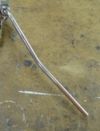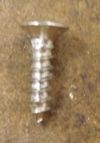Guitar bridge
From DDL Wiki
(→Assumptions) |
(→Assumptions) |
||
| Line 313: | Line 313: | ||
4. We assumed that the strings used are of the common “8-42” variety. The string diameters are 8, 11, 15, 22, 30, and 42 thousandths of an inch. The thickest three strings are thinner steel cores wrapped with wire, which provide increased linear mass without making the strings too stiff to vibrate. | 4. We assumed that the strings used are of the common “8-42” variety. The string diameters are 8, 11, 15, 22, 30, and 42 thousandths of an inch. The thickest three strings are thinner steel cores wrapped with wire, which provide increased linear mass without making the strings too stiff to vibrate. | ||
| + | |||
| + | {| class="wikitable" border="1" | ||
| + | |- | ||
| + | ! String !! Diameter (inches) !! Diameter (m) !! Core Area (m^2) !! Tension (N) !! Pressure (Pa) !! Deflection (mm) !! Standard Tuning (Hz) !! Linear Mass (kg/m) | ||
| + | |- | ||
| + | ! Row header 1 | ||
| + | | e || 0.009 || 0.000229 || 4.10e-8 || 46.1 || 1.13e9 || 5.63 || 329.6 || 0.0001673 | ||
| + | |- | ||
| + | ! Row header 2 | ||
| + | | G || 0.011 || 0.000279 || 6.13e-8 || 49.0 || 7.99e8 || 3.99 || 246.9 || 0.0003163 | ||
| + | |- | ||
| + | ! Row header 3 | ||
| + | | G || 0.011 || 0.000279 || 6.13e-8 || 49.0 || 7.99e8 || 3.99 || 246.9 || 0.0003163 | ||
| + | |- | ||
| + | ! Row header 4 | ||
| + | | G || 0.011 || 0.000279 || 6.13e-8 || 49.0 || 7.99e8 || 3.99 || 246.9 || 0.0003163 | ||
| + | |- | ||
| + | ! Row header 5 | ||
| + | | G || 0.011 || 0.000279 || 6.13e-8 || 49.0 || 7.99e8 || 3.99 || 246.9 || 0.0003163 | ||
| + | |- | ||
| + | ! Row header 6 | ||
| + | | G || 0.011 || 0.000279 || 6.13e-8 || 49.0 || 7.99e8 || 3.99 || 246.9 || 0.0003163 | ||
| + | |} | ||
Figure 1: | Figure 1: | ||
Revision as of 22:56, 19 September 2008
Contents |
Executive Summary
Executive Summary will go here. Assigned to Jeremy.
Stakeholders and Needs
Stakeholders and Needs will go here. Assigned to Mike.
Use of the Current Design
Use of Current Design will go here. Assigned to Mike.
How the Current Design Functions
Assigned to Mike.
List of Parts with Functions and Illustrations
Assigned to Aaron.
DFMA
Assigned to Jonathan.
FMEA
Assigned to Jonathan.
DFE
Assigned to Jonathan.
Mechanical Analysis
Assigned to Jeremy.
Summary of Quantitative Analysis
In our quantitative analysis, we chose to analyze the forces acting upon the bridge. As an offshoot of this, we were also able to analyze the effect of using the bridge on the pitch of the strings. We determined that although each of the components of the guitar bridge act in an easily predictable linear fashion, the complex combination of all the factors combine together into a very non-linear system. The main independent variable of our device is the angle that the bridge is depressed by the guitarist. We called this variable theta.
For our analysis, we used a simplified, but relatively accurate model of the guitar bridge. The Floyd Rose bridge is functionally very similar to our bridge model. The original Fender bridge has a number of design flaws which introduce large unpredictable changes to the forces on the strings, which we could not model easily. Consider our model a “best case scenario” for a pivoting bridge. Any tuning problems with our model would be exacerbated, not alleviated in a real world implementation.
Assumptions
1. The strings are fixed at both the bridge and the nut. Without this assumption, the unpredictable shifting of the strings at the tuners and ball-ends introduces additional tuning problems. The Floyd Rose bridge employ’s clamps at the bridge and nut which fix the strings.
2. Strings behave as steel linear springs. Strings are made of nickel steel alloys. Since the exact recipe for the steel is a closely guarded industry secret, we assumed the properties of the strings match that of standard stainless steel. The density of stainless steel is 7800 kg/m3 and the elastic modulus is 200 GPa.
3. The guitar neck and body do not deform. In a real guitar, the body and neck are made of wood, and deform under the tension of the strings. This deformation is very small, and we chose to ignore it for simplicity.
4. We assumed that the strings used are of the common “8-42” variety. The string diameters are 8, 11, 15, 22, 30, and 42 thousandths of an inch. The thickest three strings are thinner steel cores wrapped with wire, which provide increased linear mass without making the strings too stiff to vibrate.
| String | Diameter (inches) | Diameter (m) | Core Area (m^2) | Tension (N) | Pressure (Pa) | Deflection (mm) | Standard Tuning (Hz) | Linear Mass (kg/m) | |
|---|---|---|---|---|---|---|---|---|---|
| Row header 1 | e | 0.009 | 0.000229 | 4.10e-8 | 46.1 | 1.13e9 | 5.63 | 329.6 | 0.0001673 |
| Row header 2 | G | 0.011 | 0.000279 | 6.13e-8 | 49.0 | 7.99e8 | 3.99 | 246.9 | 0.0003163 |
| Row header 3 | G | 0.011 | 0.000279 | 6.13e-8 | 49.0 | 7.99e8 | 3.99 | 246.9 | 0.0003163 |
| Row header 4 | G | 0.011 | 0.000279 | 6.13e-8 | 49.0 | 7.99e8 | 3.99 | 246.9 | 0.0003163 |
| Row header 5 | G | 0.011 | 0.000279 | 6.13e-8 | 49.0 | 7.99e8 | 3.99 | 246.9 | 0.0003163 |
| Row header 6 | G | 0.011 | 0.000279 | 6.13e-8 | 49.0 | 7.99e8 | 3.99 | 246.9 | 0.0003163 |
Figure 1: INSERT GUITAR MODEL IMAGE HERE
Determining the String Tension
Each string on the guitar is made out of a very thin wire of nickel steel. The wire is either made of solid steel, or a solid steel core wrapped in another coil of steel wire. This wrapping allows the string to have a relatively high mass, while remaining flexible, as a solid string of the same thickness would be very hard to pluck. The wires can be viewed as springs, since under standard guitar tuning, the strings stretch an appreciable amount. Although each string can be viewed as an ideal spring, the combination of the tension forces of all six strings on the bridge is a non-linear function when compared to the angle of the tremolo.
One cause of this non-linearity is the fact that for any string, its tension vs. bridge angle function is a piecewise function. The tension in the string decreases linearly as the bridge angle increases, but when the tension reaches zero, the string does not compress like an ideal spring would. Instead, the tension remains zero. When you add together all six string functions, the resulting total plots as a curve, not a straight line.
Figure 2: Trem Angle vs. String Tension
Team Member Roles
Assigned to Jeremy.
References
ALL GROUP MEMBERS: Please put whatever references you use here in bibliographical format.








